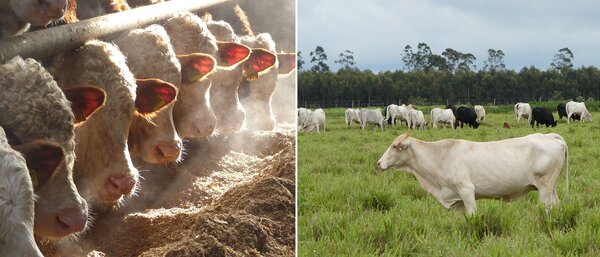Expertise
Thinking climate protection globally – The example of beef
Katrin Agethen, Claus Deblitz | 19.01.2023
How great is the potential for reducing GHG emissions in beef production? A comparison of typical production systems in Germany and Brazil shows that the German system performs better - even when Brazil uses its large reduction potentials.
In Germany, cattle for fattening mainly originate from dairy farming. Their finishing takes place in barns based on a feed ratio of silage maize, concentrated feed and grains. National production is declining: since 2015, Germany has been a net importer of beef. Besides Europe, South America is the most important region of origin for imported beef.
In Brazil, cattle are grazed all year round and come almost exclusively from suckler cow production. The country has the world’s largest cattle population and is the most important exporter of beef with an increasing export volume. Nevertheless, 80% of the beef produced is consumed domestically.
Profitability and emissions in comparison
Research conducted by the Thünen Institute in the worldwide agri benchmark network yielded interesting results. In 2021, the production of a kilogramme of beef cost about €2.80 in Brazil and about €4.10 in Germany. However, the differences in greenhouse gas (GHG) emissions are even greater, and this calculation is in favour of Germany.
The sum of emissions from digestion, farm manure management and feed production, converted into CO2 equivalents (CO2eq), is about 27 kg CO2eq per kg beef in a typical beef finishing operation in Brazil, and only about 8 kg CO2eq in a typical conventional finishing operation in Germany. One of the main reasons for this big difference is that the slow-growing cattle in Brazil produce much higher methane emissions per kilogram of beef. In the classic pasture fattening system, only the grass growth and additional minerals are available to the animals. The seasonal variation in pasture growth and the prevailing pasture management limit the finishing performance.
Possible strategies to mitigate emissions
The key to reducing GHG emissions and increasing productivity in the Brazilian system lies in pasture management, or more precisely, in subdividing huge areas of pasture into smaller plots. Higher-performing grass varieties are then used on these plots, and the cattle are moved to a fresh plot at regular intervals. This change favours feed intake as well as feed conversion and ultimately leads to faster growth of the animals. Sometimes even silvopastoral grazing systems are introduced, which make additional contributions to climate protection and climate adaptation. By combining such measures, GHG emissions per kilogramme of meat can be almost halved. In addition, the total cost per kg of beef is reduced.
IIn German beef finishing, it is mainly technical solutions that are available for GHG reduction, such as covering slurry tanks, improved spreading technology and methane inhibiting additives in feeding and slurry storage. These measures are comparatively expensive and have no positive effects on animal performance.
However, GHG emissions per kilogramme of beef are still significantly higher in improved Brazilian pasture finishing systems than from German production. This is also due to the fact that beef in Germany is mainly a by-product of milk. In Brazil, on the contrary, it comes primarily from suckler cow husbandry. In the GHG balance, the emissions from the suckler cow herd have to be fully attributed to beef, whereas in German systems a large share is attributed to the milk produced.
There are several reasons why the current practice in Brazil is being changed only hesitantly: Existing practices are profitable, at least in the short term. The necessary knowledge to switch to new land use and fattening systems is lacking. Rising variable costs mean additional financial risk. Access to capital is lacking or not very attractive. In addition, there are no climate policy incentives in Brazil or Germany that would make improving the GHG balance economically lucrative for farms.
What does this mean for climate policy?
Despite the discussions about the impact on climate, the demand for beef continues to rise globally. The strongest growth is expected in regions with comparatively high emission intensities. In contrast, the EU and Germany in particular are striving to reduce emissions from livestock farming.
This constellation can have a counterproductive effect on climate policy for an emissions-intensive product such as beef. If cattle stocks in Germany or the EU are reduced due to an ambitious climate protection policy, but the consumption of beef does not decrease to the same extent, imports with higher GHG emissions fill the gap. In the end, global cattle farming then causes more GHG emissions, not less.
The most elegant solution to this problem would be a global CO2 price that covers all sectors of the economy. Climate measures would then be automatically directed by market forces to where they have the greatest climate-protecting effect per euro. The EU wants to establish such a system, but initially without including the agricultural sector.
Since a global CO2 pricing including the agricultural sector is currently not in sight, it is worth looking for second-best solutions for the agricultural sector. This could be, for example, the inclusion of climate protection investments in bilateral trade agreements, or the introduction of a CO2 border adjustment at the EU's external borders.
The agri benchmark network is ready to support the many discussions that will certainly still take place on this issue with concrete figures from the most important production regions.







